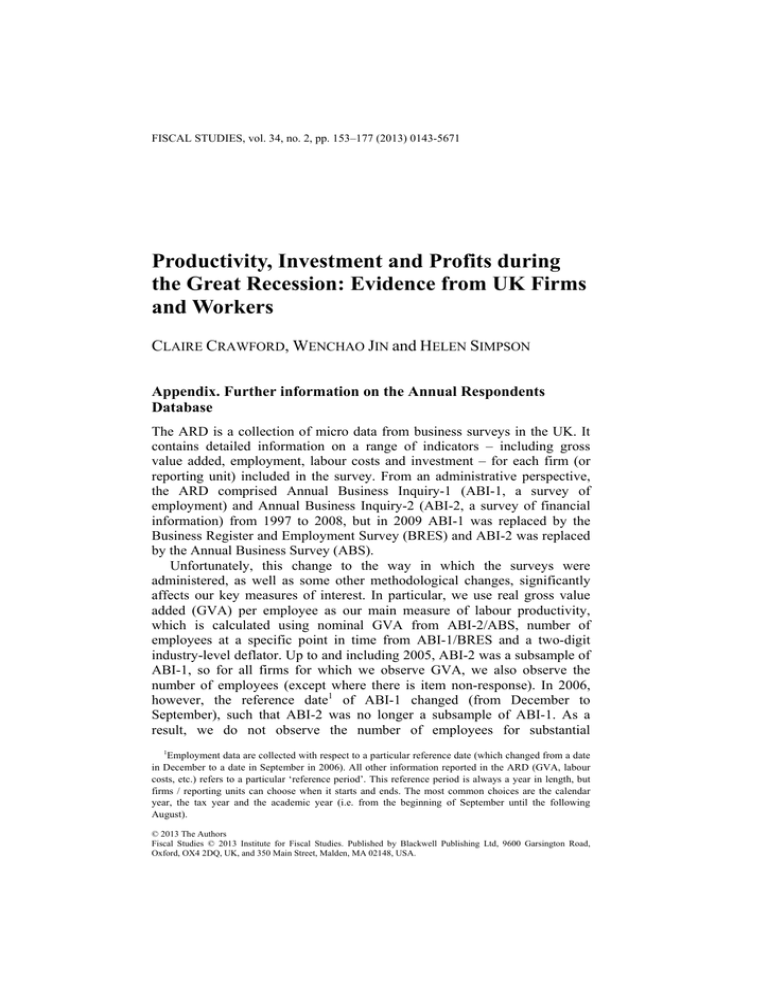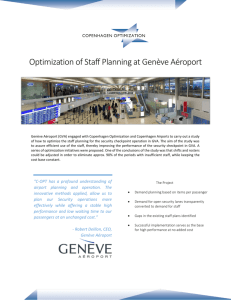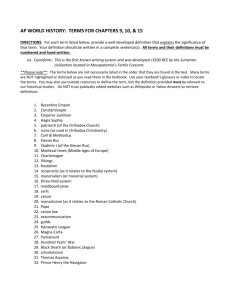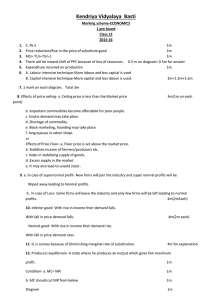Productivity, Investment and Profits during and Workers C
advertisement

FISCAL STUDIES, vol. 34, no. 2, pp. 153–177 (2013) 0143-5671 Productivity, Investment and Profits during the Great Recession: Evidence from UK Firms and Workers CLAIRE CRAWFORD, WENCHAO JIN and HELEN SIMPSON Appendix. Further information on the Annual Respondents Database The ARD is a collection of micro data from business surveys in the UK. It contains detailed information on a range of indicators – including gross value added, employment, labour costs and investment – for each firm (or reporting unit) included in the survey. From an administrative perspective, the ARD comprised Annual Business Inquiry-1 (ABI-1, a survey of employment) and Annual Business Inquiry-2 (ABI-2, a survey of financial information) from 1997 to 2008, but in 2009 ABI-1 was replaced by the Business Register and Employment Survey (BRES) and ABI-2 was replaced by the Annual Business Survey (ABS). Unfortunately, this change to the way in which the surveys were administered, as well as some other methodological changes, significantly affects our key measures of interest. In particular, we use real gross value added (GVA) per employee as our main measure of labour productivity, which is calculated using nominal GVA from ABI-2/ABS, number of employees at a specific point in time from ABI-1/BRES and a two-digit industry-level deflator. Up to and including 2005, ABI-2 was a subsample of ABI-1, so for all firms for which we observe GVA, we also observe the number of employees (except where there is item non-response). In 2006, however, the reference date1 of ABI-1 changed (from December to September), such that ABI-2 was no longer a subsample of ABI-1. As a result, we do not observe the number of employees for substantial 1 Employment data are collected with respect to a particular reference date (which changed from a date in December to a date in September in 2006). All other information reported in the ARD (GVA, labour costs, etc.) refers to a particular ‘reference period’. This reference period is always a year in length, but firms / reporting units can choose when it starts and ends. The most common choices are the calendar year, the tax year and the academic year (i.e. from the beginning of September until the following August). © 2013 The Authors Fiscal Studies © 2013 Institute for Fiscal Studies. Published by Blackwell Publishing Ltd, 9600 Garsington Road, Oxford, OX4 2DQ, UK, and 350 Main Street, Malden, MA 02148, USA. 2 Fiscal Studies proportions of the ARD sample from 2006 to 2008; we must also account for the change in reference date in our analysis.2 This problem of missing data is particularly acute in 2006, 2007 and 2008, and among smaller firms. Column 1 of Table A1 shows that the number of reporting units (RUs) with non-missing GVA and number of employees is much lower in years 2006 to 2008 than in other years; column 3 shows that the average number of employees per reporting unit is much higher in 2007 and 2008, reflecting the fact that smaller firms are more likely to have missing number of employees. The table also suggests that, even after weighting this sample, average real GVA per employee appears to have increased between 2007 and 2009 (and median real GVA per employee appears to have increased between 2007 and 2008), while the aggregate figures from the Office for National Statistics (ONS) suggest that productivity fell by 4 per cent over the same period.3 Moreover, if we split the sample by firm size – into small (fewer TABLE A1 Summary statistics of the ARD sample, by year 2002 2003 2004 2005 2006 2007 2008 2009 (1) (2) (3) (4) Average No. of RUs No. of RUs Average for which that no. of real GVA we observe represent employees per both GVA entire employee and no. of enterprises (£’000, 2008 employees prices) 40,824 39,999 11.0 37.5 40,615 39,784 10.8 36.9 40,379 39,541 10.6 40.3 39,112 38,190 10.7 43.3 25,041 24,261 11.8 41.9 22,859 21,918 15.6 41.7 14,108 13,192 26.2 46.7 34,403 33,748 8.9 60.2 (5) Median real GVA per employee (£’000, 2008 prices) 25.9 25.9 27.1 27.5 28.5 29.3 32.4 30.2 (6) Average real GVA per employee (2007 = 100) (7) Median real GVA per employee (2007 = 100) 89.9 88.4 96.6 103.8 100.5 100.0 112.1 144.4 88.3 88.6 92.6 93.9 97.3 100.0 110.8 103.1 Note: In each year, we have excluded the top and bottom 1 per cent of RUs according to GVA and number of employees. Firms with zero employees are excluded. Outcomes in columns 3 to 7 are weighted by the sample design weight ‘aweight’. We only present figures from 2002 onwards because aweight is not available from 1997 to 2001. There are around 600 RUs in years 2005 to 2008 whose enterprise identifier is missing; these RUs are not included in column 2, but they are included in all other results. 2 There was a further small change in the question on the number of employees in the firm when ABI-1 was replaced by BRES in 2009, but we do not account for this additional break in our model as it would mean that we could no longer include a single post-2008 (recessionary) dummy. Any effect that this small change might have on our estimates will therefore be conflated with our estimates of the effects of the recession on our outcomes of interest. We do not anticipate that this effect will bias our results substantially, but this is an untestable assumption. 3 Calculated using real GDP measured by ONS series ABMI and employment measured by ONS series MGRZ. © 2013 The Authors Fiscal Studies © 2013 Institute for Fiscal Studies Productivity, investment and profits during the Great Recession 3 than 50 employees), medium-sized (50 to 249 employees) and large (250 or more employees) firms – and conduct a similar exercise, we find that labour productivity in large enterprises fell significantly in 2008 and recovered to around the 2007 level in 2009, while it increased in both 2008 and 2009 in small enterprises. This is in sharp contrast to the findings documented in Bank of England (2012) and Field and Franklin (2013), who both found evidence of larger productivity falls on average amongst smaller firms. While we would not necessarily expect to be able to match productivity estimates derived from micro and macro data exactly4 – not least because productivity is extremely difficult to measure and hence is likely to be measured with a large amount of error, particularly amongst public sector organisations (which we exclude from our analysis for this reason) – the sizeable discrepancies that we observe are nonetheless concerning. With this in mind, we choose to use firm fixed effects in our regression analysis to control for firm-specific unobservables, and hence identify effects from within-firm variation. Table A2 reports regressions with labour productivity as the outcome variable using fixed effects (FE) and ordinary least squares (OLS), for three different samples. The entire sample covers 450,477 observations of 268,319 unique reporting units from 1997 to 2009, as seen in the first two columns. Among them, 88,355 RUs appear at least twice and correspond to 270,513 TABLE A2 Impact of the recession on labour productivity: fixed effects versus ordinary least squares All RUs with nonmissing GVA and employee data Post08 Post06 Year No. of obs. No. of RUs (1) FE –0.032*** (0.007) 0.008 (0.005) 0.021*** (0.001) (2) OLS 0.029*** (0.008) –0.003 (0.006) 0.024*** (0.001) 450,477 268,319 All RUs with nonmissing GVA and employee data that appear at least twice (3) FE –0.032*** (0.007) 0.008 (0.005) 0.021*** (0.001) (4) OLS 0.067*** (0.009) –0.010 (0.007) 0.024*** (0.001) 270,513 88,355 All RUs with nonmissing GVA and employee data that appear at least once before and once since 2008 (5) (6) FE OLS –0.038*** –0.039*** (0.007) (0.010) –0.015** –0.074*** (0.007) (0.011) 0.021*** 0.029*** (0.001) (0.002) 94,828 21,506 Note: Standard errors are given in parentheses and are clustered at the RU level for OLS regressions. *** denotes significance at the 1 per cent level, ** at the 5 per cent level and * at the 10 per cent level. 4 See Field and Franklin (2013) for further discussion of this issue. © 2013 The Authors Fiscal Studies © 2013 Institute for Fiscal Studies 4 Fiscal Studies observations in columns 3 and 4. Of these, 21,506 RUs appear at least once before and once since the beginning of the recession, corresponding to 94,828 observations in the last two columns. Columns 1 and 3 report the same estimates because, under FE, RUs that appear only once do not affect the estimates. The FE estimates show a 3.2 percentage point fall in labour productivity relative to the pre-recession trend. When restricting the sample to observations that appear both before and since 2008, the FE and OLS estimates are similar, at just below 4 percentage points. The sensitivity of the OLS estimates with regard to the sample suggests that compositional shifts over time or panel imbalances are non-negligible. References Bank of England (2012), ‘Output and supply’, Inflation Report: November 2012 (http://www.bankofengland.co.uk/publications/Documents/inflationreport/ir12nov.pdf). Field, S. and Franklin, M. (2013), Micro-Data Perspectives on the UK Productivity Conundrum, Office for National Statistics (http://www.ons.gov.uk/ons/dcp171766_ 295470.pdf). Office for National Statistics, Annual Respondents Database, 1973-2009: Secure Data Service Access [computer file]. 3rd Edition. Colchester, Essex: UK Data Archive [distributor], June 2012. SN: 6644 (http://dx.doi.org/10.5255/UKDA-SN-6644-3). © 2013 The Authors Fiscal Studies © 2013 Institute for Fiscal Studies





